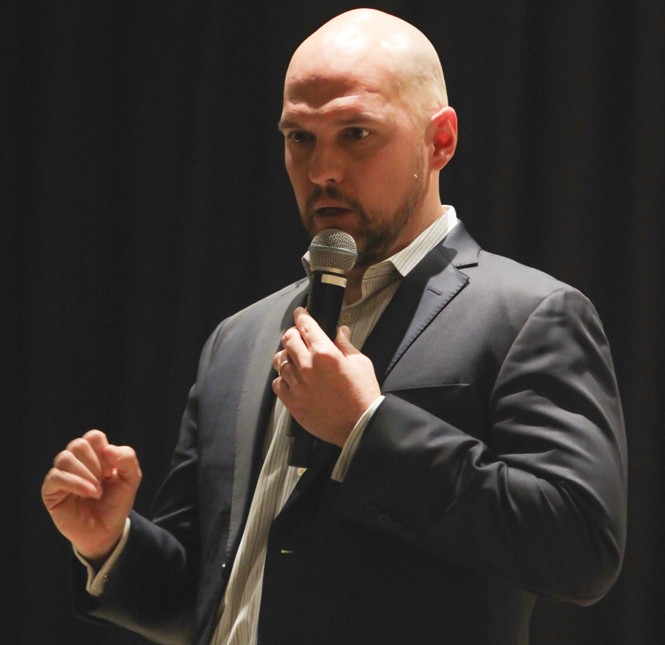News
MBA student gives talk about role in capture of Saddam Hussein
Eric Maddox, a student in Washington University’s executive MBA program and the interrogator whose efforts led to the capture of Saddam Hussein, the former dictator of Iraq, spoke in Emerson Auditorium about his experiences with the military on Feb. 5.
Maddox recalled his time in Iraq and the interrogation methods he used that led him to find Hussein’s most-trusted bodyguard. He also discussed how the army used that intelligence to find Hussein in 2003.
Operation Red Dawn was carried out successfully the day after Maddox left Iraq to begin his return to the United States. Using the intelligence Maddox garnered through interrogations of prisoners, Hussein was captured near Tikrit, Iraq.
 Skyler Kessler | Student Life
Skyler Kessler | Student Life Eric Maddox, an interrogator who helped with the capture Saddam Hussein, speaks in Emerson Auditorium on Thursday. Maddox said he has interrogated more than 2,700 prisoners in his time with the military.
Maddox, who joined a team of interrogators obtaining intelligence in order to track down the most wanted people in the war, was only meant to stay in Tikrit for one day. Instead, he and his team ended up staying for six months to interrogate every prisoner the team brought in.
Ultimately, after over 200 prisoners and three months of interrogation, a prisoner gave up the name of Mohammed Ibrahim Omar al-Muslit, one of Hussein’s most trusted bodyguards.
Though Maddox believed that Hussein might be hidden in Tikrit, the military was unconvinced, which, according to Maddox, is why they probably sent the most inexperienced person, given that he had never conducted an actual interrogation before.
The hunt for Ibrahim led Maddox to Baghdad, where they raided Ibrahim’s aunt and uncle’s house and captured what they thought were three random men. While Maddox knew what Ibrahim was supposed to look like, he had never actually seen him.
“I lifted the hood off the third prisoner and before I even took it off, I saw that chin,” Maddox recounted. “And I said, ‘You’re Mohammed Ibrahim, man I’ve been waiting to meet you.’ And he looks at me and he said, ‘Yeah, I’ve been waiting to meet you too.’”
Maddox told the story of how, with only a couple of hours until he would leave Iraq to make his way back home, he tried to break Ibrahim and get him to reveal Hussein’s location, but Ibrahim refused.
“I looked at [Ibrahim] and I said, ‘Listen, when I leave, no one’s giving you that chance again. Nobody knows what you can do, but me. When I leave here, you’re just going to be the terrorist that spends the rest of their life in prison. I need him now,’” Maddox said.
Soon after, Ibrahim finally told Maddox where Hussein was located.
Maddox reported this intelligence to his superiors but was subsequently sent to Qatar as he was due to return to the U.S. The next day, he learned that the Delta Force team used Ibrahim’s intelligence and found Hussein.
Maddox also fielded questions from the audience, which ranged from what it’s like to work with a translator to which types of people are easier to “break” and torture.
“Here’s the policy that I would love to tell the president or Congress or whoever the decision makers are: was there torture? Yes. Yes, we all know that. If you don’t, there was,” Maddox said. “But they’re not mean people; there’s probably no more intelligent group of workers in the military than the interrogators.”
Maddox stressed that interrogators resorted to torture because the old techniques weren’t working. Even for himself, he had to resort to his new method because the old techniques weren’t breaking his prisoners.
“When do we address the fact that the old techniques don’t work?” Maddox said. “They don’t work, but when have you ever heard anyone in the news say, ‘Well, what are they supposed to do, because what we teach at the best interrogation course in the world does not work.’ That’s how you address the issue, but it’s so hard for a military to admit.”
In total, Maddox said he has interrogated over 2,700 prisoners from 25 different countries.
The event was organized by the Young Presidents’ Organization—Next Generation group on campus. The group is a subset of the Young Presidents’ Organization—World Presidents’ Organization, which is a network of CEOs from around the world. The “next-generation” group is for children of members in YPO-WPO.
The group is not funded by Student Union because of its specific eligibility requirements but has gotten support from the Olin Business School.
Sophomore Lauren Kliska started the club a year and a half ago. She said she had a difficult time finding other eligible members and balancing advertising to find eligible members without advertising to everyone. This was the group’s first event.
Sophomore Erica Achepohl enjoyed hearing Maddox’s story.
“I thought it was an incredible opportunity to get to hear someone with such vast intelligence and knowledge speak, and I thought that it was a fantastic job and I really appreciated the YPO for putting it on,” she said.
Freshman Andrew Gong echoed similar sentiments.
“I thought his experiences were really cool to hear about and he did a great job telling the story of how he helped them catch Saddam. It was an entertaining and educating presentation,” he said.
